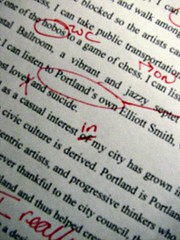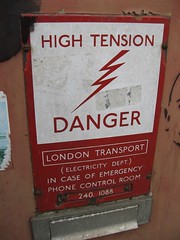by Julie Coulter Bellon
 My secret sauce in making the leap to being a published author was learning how to be a better self-editor. I think when you know the areas to look for that are your personal weaknesses as a writer, you can better learn the craft to make that your strength.
My secret sauce in making the leap to being a published author was learning how to be a better self-editor. I think when you know the areas to look for that are your personal weaknesses as a writer, you can better learn the craft to make that your strength.
Here is my personal self-editing checklist.
First I do the CLAW
I start with the easy stuff because it makes me feel good to check it off.
Check for basic editing errors like:
- Page numbering and blank pages
- Too many adjectives or adverbs: “It was a beautiful sunny June day and the lush, emerald green grass reflected the bright yellow sunlight and hurt my eyes. Or, “She desperately wanted to kiss him passionately.”
- Tense consistency and subject/verb agreement: “He couldn’t believe that his boss had fired him over a typographical error. He is a great worker and always turns in his projects on time.” Subject/verb agreement, “He run to the store.”
- Clichés: “She’ll come crawling back to me.” “He couldn’t beat around the bush any longer.”
- Repetitious descriptions: Weave in your first descriptions and make them powerful enough that you don’t have to beat your reader over the head with more.
- Favorite words: “really” “just” “some” “that”
- Too many dialogue tags or weird tags: James laughed at her pain. “Don’t bother trying to get away,” he replied. We don’t need the replied because we know it’s James talking. And use “said,” in most instances because when you try to get fancy “he pontificated,” or “she remonstrated,” it can take the reader out of the story.
- Chapter or POV breaks. Double check that those are correct and done.
Let someone else read it that will give me good feedback. Not my mother or grandma, but someone who will be honest and somewhat brutal.
Always print it out and read a hard copy. Mistakes will jump out at me that way. Sometimes putting it into a different font can also be helpful in spotting mistakes.
Walk-away for a few hours, days or weeks and come back with fresh eyes. I’ve created something and I need a bit of time to enjoy that, but I keep thinking about it, and when I come back to it, I’m ready to make the changes I need to. Anything that doesn’t advance the story must be cut out, even if it’s my favorite part.
So, now I’ve done the basic CLAW checklist, then I send it out to beta readers for some feedback. But I don’t wait around for them to get back to me. While they have it, I print it out myself and read it front to back for any other little changes I might want to make. Once that’s done, I’m ready for the second round of self-editing.
My second round of self-editing is where I go through that hard copy and look for specific problem areas. (For some reason I see mistakes better on a hard copy. It can be done on the computer as well. Maybe I’m just getting old, or my old journalism habits are coming through!)
(Also, I know I’ve seen a lot of these areas on Jordan’s previous secret sauce blog entries and I have to say I’ve learned a lot from them and for my next book I can delve even deeper into some of these.) Here’s my specific list for the second round.
Second Round of Self-Editing—The Editor’s Checklist
- Show don’t tell—show us what your character is experiencing in that moment. What does he/she hear, feel, or smell? Let the reader be in the moment with them.
- Passive voice—the lady is being kissed by a masked man. The masked man is kissing the lady.” Keep it active and concentrate on the action.
- POV shifts—usually one POV per scene
- Chapter hooks, beginning and end. Make the reader want to keep on turning pages.
- Does each character have a motivation?
- Is the setting done well? Does it contribute to the piece?
- Is the story timeline consistent?
- Does the conflict keep the tension throughout the story?
- Do you have a natural flow—nothing contrived?
- Is there a balance of narrative, action, and dialogue?
This round takes a bit more time, but it is totally worth it when I catch mistakes like my character having blue eyes in chapter one that magically change to brown eyes in chapter fifteen. Going through the manuscript ten times looking for specific issues like the ones above has saved me so many times. (That’s why I can never show people my first or even fifth drafts! You would laugh.) Also, by the time you’re done going through it so many times you’re going to hate your manuscript and that’s always a good sign that it’s close to being finished!
Which leads me to the last round of self-edits—the big picture issues.
Do You Know Your Big Picture Problem Areas?
(If you find problems here, you will bang your head against the wall for a while trying to fix it, but make no mistake, you will be glad you fixed it at this stage instead of when a reader/editor/agent tells you.) (See what I did there? Make no mistake? Haha)
Characterization—Are we privy to the main character’s thoughts, or do we only skim his/her surface? Is this a character we simply witness, or a character we understand deeply?
Plot—Is your plot contrived or unbelievable? Do you know the end and work toward a satisfying conclusion with no dangling loose ends or unnecessary beats? Are there elements of truth in it that readers can relate to?
Continuity—Are your characters consistent throughout with no name changes, eye color changes or backstory inconsistencies? Is your timeline appropriate? Are settings and events consistent?
Details—Do you have a hard time finding balance and detail people to death? Are you focusing on the small picture or keeping an eye on the big picture?
Once that is all done, there’s just one more step.
Now What? Change Hats Once More
Take off your editor’s hat and put on your writing hat again. Make the necessary changes from what you saw in your piece on your three editing rounds. Drown the piece in red ink and bring it back to life with new words and ideas. Make it flow.
I know it’s hard sometimes, but enjoy the journey of revision. Rewriting can be rejuvenating and breathe new life into your characters. Don’t be discouraged. This is your opportunity to make the story shine and bring your ideas to life. One of my favorite quotes is by Arthur Polotnik.
“You write to communicate to the hearts and minds of others what’s burning inside you. And we edit to let the fire show through the smoke.” Arthur Polotnik
Let your fire show so your readers can experience your story the way you saw it in your head.
The more you learn about yourself as a writer, the better able you are to self-edit and really improve in your craft. Of course this is one of the first steps in your journey to publishing and doesn’t substitute for a critique group and a professional edit, but once you are this far, your piece is polished enough to go on in the process.
About the Author
Julie Coulter Bellon is the mom of eight children and the author of nine books. She balances being a mom with being a writer and an avid reader. She blogs at LDS Writer Mom. Her latest release is Ashes Ashes.
 Sophia Naziri is wanted for questioning in the murder of a U.S. senator. She’s worried the police will show up on her doorstep any moment, but when Detective Colby Black appears, it’s to help her put out a kitchen fire, not take her in. Yet. His easy smile and persistence in getting to know her pushes all her troubles to the back of her mind, until a hit man tracks her down. Getting arrested becomes the least of her worries and the handsome detective could be her only way out—if she tells him the truth.
Sophia Naziri is wanted for questioning in the murder of a U.S. senator. She’s worried the police will show up on her doorstep any moment, but when Detective Colby Black appears, it’s to help her put out a kitchen fire, not take her in. Yet. His easy smile and persistence in getting to know her pushes all her troubles to the back of her mind, until a hit man tracks her down. Getting arrested becomes the least of her worries and the handsome detective could be her only way out—if she tells him the truth.
Colby Black’s sniper skills have been a blessing and a curse to him. As a member of a Hostage Negotiation Team, he can use them to save people, but sometimes he can’t protect the innocent despite his best efforts. When a hostage situation goes bad, he tries to put it behind him by helping out his mysterious next-door neighbor, Sophia Naziri. But she pulls Colby into a web of lies and conspiracy that will force him to use every skill he has in order to survive. Faced with the moment of truth, can he trust anyone around him—including the woman at the center of it all?

 Last week, I gave a class at the LDStorymakers Conference on gesture crutches. You can find my presentation here, but today I’m sharing the resources I cited in class!
Last week, I gave a class at the LDStorymakers Conference on gesture crutches. You can find my presentation here, but today I’m sharing the resources I cited in class!
 So when we’re
So when we’re 
 .
.
